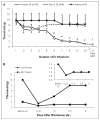Episodic dural stimulation in awake rats: a model for recurrent headache
- PMID: 17635594
- PMCID: PMC4029495
- DOI: 10.1111/j.1526-4610.2007.00871.x
Episodic dural stimulation in awake rats: a model for recurrent headache
Abstract
Objectives: To model, in rats, the development of chronic trigeminal nociceptive hypersensitivity seen in patients with recurrent headache.
Background: Pathophysiology studies suggest that patients with recurrent migraine headache experience repeated bouts of dural nociceptor activation. In some patients, the severity and frequency of headache attacks increase over time. Patients with recurrent headache are hypersensitive to nitric oxide donors, such as glyceryl trinitrate (GTN). Current trigeminal pain models do not reflect the repeated episodic nature of dural nociceptor activation in patients with recurrent headache. Repeated nociceptor activation creates long-lasting changes in the periphery and brain due to activity-dependent neuronal plasticity. An animal model of repeated activation of dural nociceptors will facilitate the study of the physiological changes caused by repeated, episodic pain and the factors important for the transition of episodic to chronic migraine.
Methods: We induced dural inflammation by infusing an inflammatory soup (IS) through a cannula on the dura in awake behaving rats. This was repeated 3 times per week for up to 4 weeks. Periorbital pressure sensory testing was used to monitor the change in trigeminal sensitivity. Rats were challenged with GTN to test the hypothesis that many dural stimulations are required to model the hypersensitivity of migraine patients. Quantitative trigeminal sensory testing and microdialysis in the trigeminal nucleus caudalis (TNC) were used to measure GTN hypersensitivity.
Results: Multiple infusions of IS (>8), over weeks, induced a long-lasting decrease in periorbital pressure thresholds that lasted >3 weeks after the last infusion. In contrast, IS infusion in IS-naive rats and those that received 3 IS infusions produced only short-lasting decreases in periorbital pressure thresholds. Rats that received more than 8 IS infusions showed a marked increase in their neurochemical and behavioral responses to GTN. In these rats, GTN induced a decrease in periorbital von Frey thresholds that lasted >5 hours. In contrast, in rats that received only 3 IS infusions, GTN caused a threshold decrease for 1.5 hour. In vivo microdialysis in the TNC showed that GTN increased extracellular glutamate levels in rats with more than 8 IS infusions to 7.7 times the basal levels. In IS-naive rats and those that received only 3 IS infusions, the extracellular glutamate levels rose to only 1.7 and 1.9 times the basal level, respectively.
Conclusions: Repeated IS stimulation of the dura produces a chronic state of trigeminal hypersensitivity and potentiates the response to GTN. This hyperresponsiveness outlasts the last IS infusion and is the basis of our rat model of recurrent headache. This model can be used to study the changes in the brain and periphery induced by repeated trigeminovascular nociceptor activation and has the potential to elucidate the mechanisms for the transition of episodic to chronic headache.
Conflict of interest statement
Figures




Similar articles
-
Pearls and pitfalls in experimental in vivo models of migraine: dural trigeminovascular nociception.Cephalalgia. 2013 Jun;33(8):577-92. doi: 10.1177/0333102412472071. Cephalalgia. 2013. PMID: 23671254 Review.
-
General trigeminospinal central sensitization and impaired descending pain inhibitory controls contribute to migraine progression.Pain. 2014 Jul;155(7):1196-1205. doi: 10.1016/j.pain.2014.03.001. Epub 2014 Mar 12. Pain. 2014. PMID: 24631586
-
PAR2 activation in the dura causes acute behavioral responses and priming to glyceryl trinitrate in a mouse migraine model.J Headache Pain. 2023 Apr 19;24(1):42. doi: 10.1186/s10194-023-01574-5. J Headache Pain. 2023. PMID: 37072694 Free PMC article.
-
The effects of the TRPV1 receptor antagonist SB-705498 on trigeminovascular sensitisation and neurotransmission.Naunyn Schmiedebergs Arch Pharmacol. 2009 Oct;380(4):311-25. doi: 10.1007/s00210-009-0437-5. Epub 2009 Aug 19. Naunyn Schmiedebergs Arch Pharmacol. 2009. PMID: 19690836
-
Investigations into the role of nitric oxide and the large intracranial arteries in migraine headache.Cephalalgia. 1997 Dec;17(8):873-95. doi: 10.1046/j.1468-2982.1997.1708873.x. Cephalalgia. 1997. PMID: 9453277 Review.
Cited by
-
Meningeal Mechanisms and the Migraine Connection.Annu Rev Neurosci. 2023 Jul 10;46:39-58. doi: 10.1146/annurev-neuro-080422-105509. Epub 2023 Mar 13. Annu Rev Neurosci. 2023. PMID: 36913712 Free PMC article. Review.
-
Assessing complex movement behaviors in rodent models of neurological disorders.Neurobiol Learn Mem. 2019 Nov;165:106817. doi: 10.1016/j.nlm.2018.02.025. Epub 2018 Feb 21. Neurobiol Learn Mem. 2019. PMID: 29476821 Free PMC article.
-
Interleukin-6 induces spatially dependent whole-body hypersensitivity in rats: implications for extracephalic hypersensitivity in migraine.J Headache Pain. 2021 Jul 13;22(1):70. doi: 10.1186/s10194-021-01286-8. J Headache Pain. 2021. PMID: 34256692 Free PMC article.
-
Induction of chronic migraine phenotypes in a rat model after environmental irritant exposure.Pain. 2018 Mar;159(3):540-549. doi: 10.1097/j.pain.0000000000001124. Pain. 2018. PMID: 29200178 Free PMC article.
-
Recovery From Repeat Mild Traumatic Brain Injury in Adolescent Rats Is Dependent on Pre-injury Activity State.Front Neurol. 2021 Jan 8;11:616661. doi: 10.3389/fneur.2020.616661. eCollection 2020. Front Neurol. 2021. PMID: 33488505 Free PMC article.
References
-
- Reuter U, Bolay H, Jansen-Olesen I, et al. Delayed inflammation in rat meninges: Implications for migraine pathophysiology. Brain. 2001;124:2490–2502. - PubMed
-
- Goadsby PJ. Recent advances in understanding migraine mechanisms, molecules and therapeutics. Trends Mol Med. 2007;13:39–44. - PubMed
-
- Burstein R, Jakubowski M. Unitary hypothesis for multiple triggers of the pain and strain of migraine. J Comp Neurol. 2005;493:9–14. - PubMed
-
- Burstein R, Jakubowski M, Levy D. Anti-migraine action of triptans is preceded by transient aggravation of headache caused by activation of meningeal nociceptors. Pain. 2005;115:21–28. - PubMed
-
- Bolay H, Reuter U, Dunn AK, Huang Z, Boas DA, Moskowitz MA. Intrinsic brain activity triggers trigeminal meningeal afferents in a migraine model. Nat Med. 2002;8:136–142. - PubMed
Publication types
MeSH terms
Substances
Grants and funding
LinkOut - more resources
Full Text Sources
Other Literature Sources
Medical
Miscellaneous

